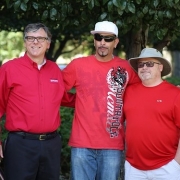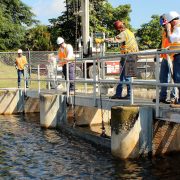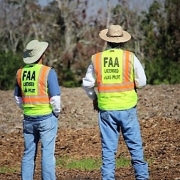Man-made stormwater ponds are attractive enhancements to many residential communities and businesses within the Lake Worth Drainage District (LWDD). More importantly, these waterbodies serve an important public safety purpose as they are part of the overall flood control system.
When it rains, stormwater flows into the retention pond and, if needed for flood control, out through the pond’s discharge control structure into the LWDD canal. Most of the time this drainage occurs unnoticed by the average individual. However, during a severe storm, flooding in streets, sidewalks, and driveways may occur. This nuisance flooding may cause concern, but it is important to note these low-lying areas are designed as secondary detention areas to protect buildings and homes from flooding.
Within LWDD, flood control is a shared responsibility and achieved through an interconnected, 3-tiered drainage system governed by 3 unique groups of people. Through communication and coordination, these 3 groups can provide effective flood control. The groups are identified as:
- Neighborhood drainage systems operated by property owners or residential associations
- Secondary drainage systems operated by LWDD or municipalities
- Primary drainage system operated by the South Florida Water Management District
Water managers in charge of primary and secondary systems are continually monitoring the weather and canal levels to proactively respond to changes in canal elevations. In anticipation of a heavy rainfall event, water managers will make operational adjustments to maintain appropriate water elevations for flood control. Additionally, throughout the year routine canal maintenance is conducted to provide unobstructed flow in the canal channel and access along the canal rights-of-way. The inspection of control structures, pumps and other infrastructure is also conducted, and repairs or replacements are made.
Property owners and residential associations have a similar role regarding their neighborhood drainage system. They must maintain their drainage infrastructure to ensure that inlets, storm drains, pipes, and discharge control structures are free of potential blockages and working as designed, thus maintaining the flow of stormwater away from their property. An annual inspection of the drainage infrastructure should be made, and repairs should be completed before the start of the storm season on June 1.
Neighborhood drainage systems with operable discharge control structures can request permission from LWDD to open their structure prior to a severe storm. This will provide additional onsite storage capacity within the stormwater pond. Additionally, this group should register with LWDD the individuals who are responsible for the maintenance of the neighborhood drainage system and control structure operation. It is recommended that communities update this registration at least once a year to verify the contact information is current. This will ensure that important weather alerts and instructions are being sent to the appropriate designated individuals. A registration form can be found on LWDD’s website at https://lwddnet.wpengine.com/2296-2.






